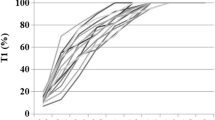Abstract
Objective.To determine the relationship between the rate ofrocuronium injection and the onset time of neuromuscular block. Methods.After intravenous induction, 60 female patients (ASA I–II) wereassigned randomly into 3 groups for rocuronium administration within1–15, 15–30 or 30–60 seconds. Acceleromyography of the thumbwas performed using train-of-four (TOF) stimulation. Times to 50% and 90%twitch depression of the first twitch of the TOF stimulation (T1) wererecorded. Results.Injection time significantly influences time to 50%relaxation, but not time to 90% relaxation. Body mass index is negativelycorrelated with time to 50% and 90% relaxation. Conclusions.Weconclude that rate of injection influences only the initial phase ofdevelopment of the block and that slower injection times do not significantlyaffect time to 90% relaxation at the adductor pollicis muscle.
Similar content being viewed by others
REFERENCES
Puhringer FK, Keller C, Kleinasser A, Giesinger, Benzer A. Pharmacokinetics of rocuronium bromide in obese female patients. Eur J Anaesthesiol 1999; 16: 507-510
Beaufort TM, Proost JH, Kuizenga K, Houwertjes MC, Kleef UW, Wierda JMKH. Do plasma concentrations obtained from early arterial blood sampling improve pharmacokinetic/pharmacodynamic modeling? J Pharmacokin Biopharm 1997; 25: 23-37
Meistelman C, Plaud B, Donati F. Rocuronium (ORG 9426) neuromuscular blockade at the adductor muscles of the larynx and adductor pollicis in humans. Can J Anaesth 1992; 39 (7): 665-669
Plaud B, Proost JH, Wierda JMKH, Barre J, Debaene B, Meistelman C. Pharmacokinetics and pharmacodynamics of rocuronium at the vocal cords and the adductor pollicis in humans. Clin Pharmacol Ther 1995; 58: 185-191
De Mey JC, Debrock M, Rolly G. Evaluation of the onset and intubation conditions of rocuronium bromide. Eur J Anaesthesiol 1994; 11 (Suppl 9): 37-40
Author information
Authors and Affiliations
Rights and permissions
About this article
Cite this article
De Haes, A., Eleveld, D.J. & Wierda, J.M.K.H. The Relationship Between Rate of Administration of an Intubating Dose of Rocuronium and Time to 50% and 90% Block at the Adductor Pollicis Muscle. J Clin Monit Comput 16, 219–222 (2000). https://doi.org/10.1023/A:1009964305762
Issue Date:
DOI: https://doi.org/10.1023/A:1009964305762




